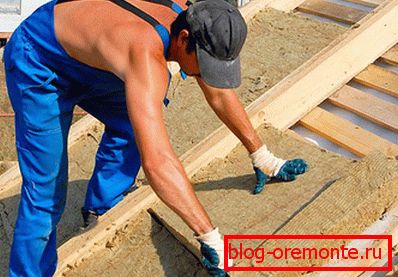Roof insulation with mineral wool: methods of thermal
The most important component of the design of any building is the roof, which protects it from the damaging effects of bad weather and is subject (like all other elements of the building) to reliable insulation. Most often, well-known mineral wool is used as a thermal protection in roof constructions. Warming the roof with this material allows you to reduce heat loss through the coating of the building in the harsh winter season, as well as protect it from overheating on hot summer days.

Note that the most stringent requirements for thermal insulation of the roof in the case when it is planned to place the attic floor under it.
Materials used

Before starting work on the thermal protection of the roof, you should decide on the choice of thermal insulator. For these purposes most often used:
- mineral (basalt) wool;
- polystyrene in plates;
- sawdust;
- backfill of expanded clay.
The choice of one or another type of heat insulator is determined by the capabilities and preferences of a particular artist. In most cases, mineral wool is traditionally used. This article will be considered in more detail in our article.
Advantages and disadvantages

The use of mineral wool as a roof insulation has a number of advantages, the main of which are:
- high degree of resistance to fire;
- lack of emissions harmful to human health;
- excellent thermal insulation characteristics;
- ease of laying blanks due to its low weight.
The disadvantages of such heat protection are usually considered to be its high hygroscopicity, contributing to the saturation of the material with moisture, followed by its destruction for this reason. Before warming your roof with mineral wool, be sure to worry about the arrangement of high-quality hydro and vapor insulation, providing reliable protection from moisture evaporation.
General work order

The organization of the insulation works carried out in the process of preparing the roofing pie prior to the laying of the coating implies their gradual execution in the following sequence:
- On the inside of the truss system, a special lathing is used, which is used to hold the insulating material in the space between the rafters. The choice of the fastening step of its strips is selected on the basis of the size of the blanks of the thermal insulator (within 20–30 cm).
- Then plates of mineral wool are placed in the spaces between the truss legs (as a rule, in one, sometimes in two layers). During installation, it is necessary to ensure that no through holes are formed in the layer of laid insulation, and the edges of the plates are located close to the rafters.
- Upon completion of the laying of mineral wool slabs, you can proceed to the installation of waterproofing, which is stuffed to the rafter legs over the heat insulating mats (sheets) and is attached to them not in stretch, but with some sagging.
- At the final stage of work from the inside (on the lathing), polyethylene film is filled, used as a vapor barrier protecting the material from moisture evaporation.
Insulation of various designs

The cheapest and relatively simple variant of warming the roof of the mineral wool assumes its installation directly on concrete slabs or wooden structures of flat floors.
For flat roofs should be used rigid insulation boards, characterized by increased density (more than 150 kg / m3) with a layer of waterproofing deposited on them. When laying insulation thickness of 25 cm of the workpiece should be positioned as closely as possible one to another; at the same time docking seams should not be in one line (laying in a run-up or with dressing).
Thermal insulation of pitched structures with a truss system will require a large amount of time and effort from the contractor. In this case, the consumption of the insulator used increases, as well as the total amount of installation work increases, which is explained by the complexity of the truss system and the need for organizing additional fasteners. To fill the spaces between the rafters, dense elastic wool with a low specific gravity and density not lower than 40 kg / m should be used.3.
If the thickness of the rafters exceeds the thickness of the sheets of mineral wool, it is laid in two layers. The second layer should be placed across the first, which ensures the overlap of the joints of the lower row, excluding the possibility of the formation of cold bridges during the operation in the winter period.
Features of working with basalt wool

The peculiarity of using basalt wool is the possibility of partial reduction of material consumption, which allows to simplify its installation somewhat. This is due to the remarkable properties of basalt (or stone) mineral insulation:
- absolute incombustibility;
- high rates of vapor impermeability;
- biological resistance;
- immutability of form;
- excellent sound insulation and dielectric characteristics.
This material can simultaneously be used both as a thermal insulation and as a fireproof barrier in roofing structures of the most various classes. When using stone wool, the need for the arrangement of vapor barrier protection in some cases completely disappears.

When insulating the roofs of industrial buildings, the dielectric properties of stone insulation, as well as its immunity to aggressive media and good sound insulation are highly appreciated. Basalt wool is quite technological; it is easily cut and cut, which allows it to be used for thermal insulation of complex roofing structures.
Basalt heat insulator for various types of roofs is sold in rolls, as well as in the form of semi-rigid and rigid slabs with or without foil coating.